Every once in a while, I like to shift gears and talk about comics set outside Gotham City that Batman fans should nevertheless enjoy because their genres (crime, superhero, fantastic adventure) are close to the mood of the Dark Knight. This month I’m taking it one step further: each week, I’ll be looking at comics about street vigilantes who don’t dress as bats yet also kick tons of ass.
To get things started, let’s have a look at Mike Grell’s extraordinary run on Green Arrow (1987-1994):
First, some context. Oliver ‘Ollie’ Queen, aka Green Arrow, had been around since 1941. He operated out of Star City and his main gimmick was archery, with Ollie’s weapon of choice being trick arrows (including an infamous one tipped with a boxing glove). That said, for most of his crime-fighting career Green Arrow had been little more than a Batman knockoff. He was a billionaire playboy with a teen sidekick (Roy Harper, aka Speedy). He even drove an Arrow-Car and flew an Arrow-Plane and his headquarters were an Arrow-Cave and he was summoned by a freaking Arrow-Signal!
The Brave and the Bold cartoon had a lot of fun implying that basically Batman and Ollie had an alpha male dick competition going on. Regardless, the fact is that their team-ups really gelled, both in the show and in the comic (especially in the neat stories ‘The Senator’s Been Shot!’ and ‘Double Your Money – and Die!’). Green Arrow even played a memorable role at the climax of The Dark Knight Returns.
Expanding on the whole archer motif, in 1969 Green Arrow became more like Robin Hood. Neal Adams redesigned his looks to bring him closer to Errol Flynn while Denny O’Neil turned him into DC’s voice of social consciousness. Writers found in the ‘left wing hero’ persona a way to carve out a niche for the character and, crucially, to help distinguish him from Batman’s more by-the-book, law-and-order, keeper-of-the-status-quo attitude:
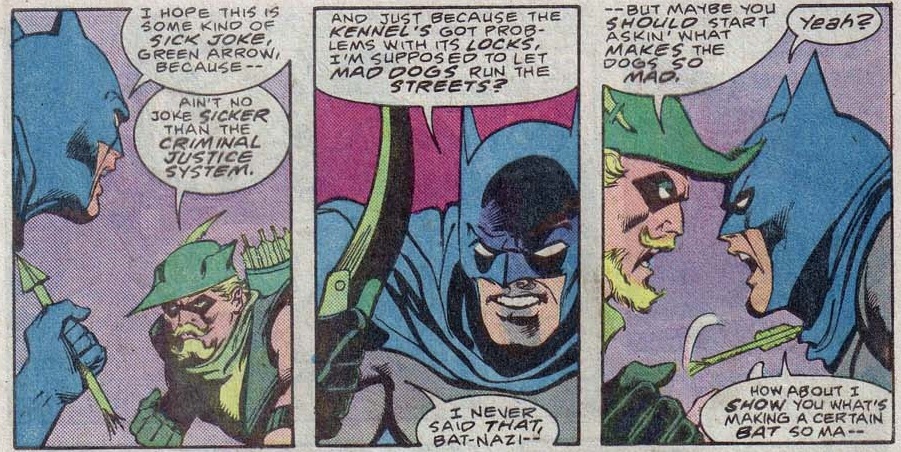 Detective Comics #559
Detective Comics #559
Which brings us to Mike Grell’s The Longbow Hunters, a 1987 prestige format mini-series which revamped Green Arrow with a more realistic and oh-so-eighties’ vibe. In fact, this is about as ‘eighties’ as a comic can get: there’s drugs, sex, serial killers, the Yakuza, gallons of graphic violence (particularly towards women), post-Vietnam trauma, and a whole subplot inspired by the Iran-Contra scandal.
If you’re into grit, though, this is as good as it gets. And let’s be fair, there is some enduring appeal to that kind of intense ‘80s mood (which is why we’ve seen so many great throwbacks to that period in recent movies such as Cold in July, The Guest, and House of the Devil). While there were plenty of cringeworthy, uninspired attempts to ride the post-Watchmen, post-Dark Knight Returns grim ‘n gritty comics wave, The Longbow Hunters actually pulled it off. Grell wrote Oliver Queen as an ageing romantic (just turned 43), in a mature relationship, coming to terms with the complexities of a brutal world. The book densely and powerfully overlapped symbols and narrative strands.
It also benefitted from gorgeous art by Mike Grell and Lurene Haines, with colors by Julia Lacquement:
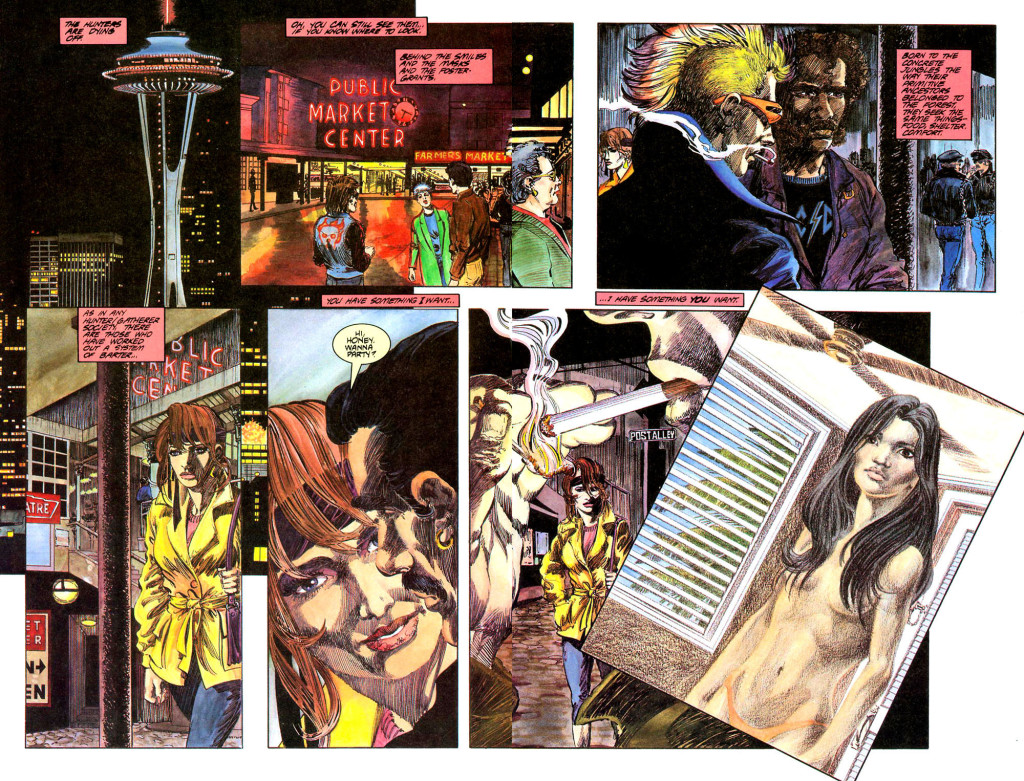 The Longbow Hunters #1
The Longbow Hunters #1
The Longbow Hunters built on some of Green Arrow’s established elements (including his love for Robin Hood and Errol Flynn) while throwing others completely out the window. Oliver Queen moved to Seattle with his girlfriend Dinah Lance (aka Black Canary) and did away with the trick arrows and the most ridiculous features of his costume. This was a soft reboot, though, with Grell briefly acknowledging the past and showing, in-story, the characters’ decision to evolve. For example, you can still see a bunch of old trick arrows in the basement as Dinah explains to Ollie that the new costume is more practical for Seattle weather.
Dinah’s subplot is the most notorious aspect of the comic, as she is captured and tortured (although not, as some insist, raped), leading Ollie to kill in order to rescue her. For better or worse, this reinforced Mike Grell’s dark, pull-no-punches approach, soon carried into a peerless, long-running Green Arrow series for which he wrote the first 80 issues.
As impressive as The Longbow Hunters was, what followed was a tremendous action series. Seriously, you knew they were doing something right because you didn’t even find yourself questioning how a guy armed with a bow and arrow repeatedly managed to outdraw dudes carrying guns! Of course, it helped that penciller Ed Hannigan and inker Dick Giordano were the first team to take over art duties, because those two can get away with murder. Even better, not only did we get truly stylish inside art, but also a set of covers that almost rivals their work on Batman:
To be fair, Mike Grell painted some pretty amazing covers as well:
Running with the notion that Green Arrow was an urban hunter and criminals his prey, Mike Grell effectively wrote the comic as a ‘mature readers’ crime book with some two-fisted adventure and espionage thrown in for good measure (there was even occasional swearing and nudity). Many stories were tight, two-part mysteries, although Grell kept shaking up the status quo, thus preventing things from becoming too formulaic. My favorite of these is probably ‘Moving Target’ (issues #13–14), a taut whodunit full of great character work and fine Dan Jurgens art:
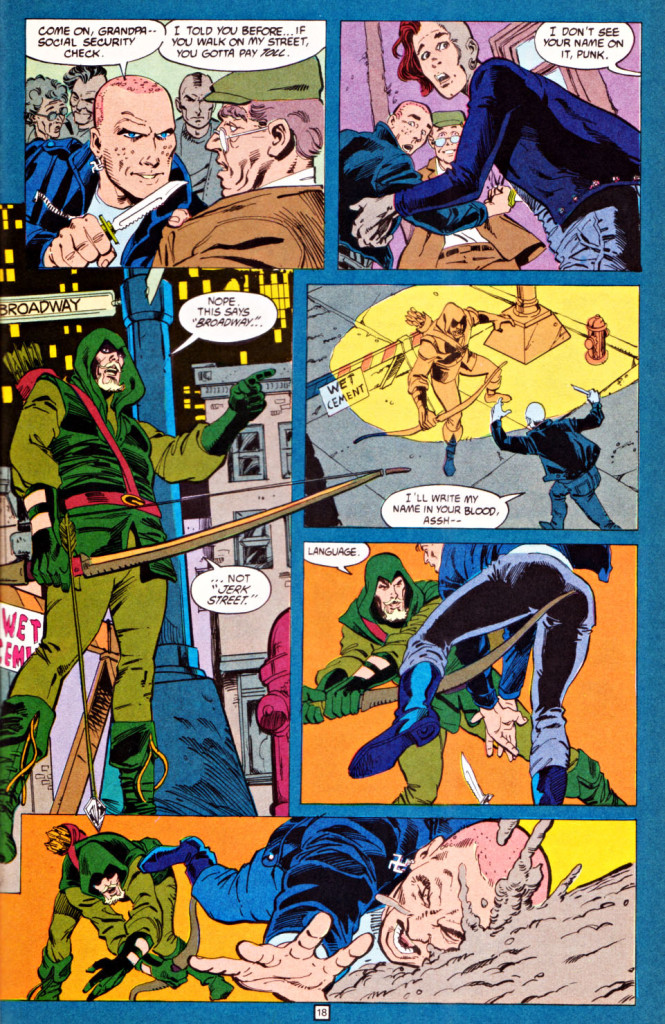
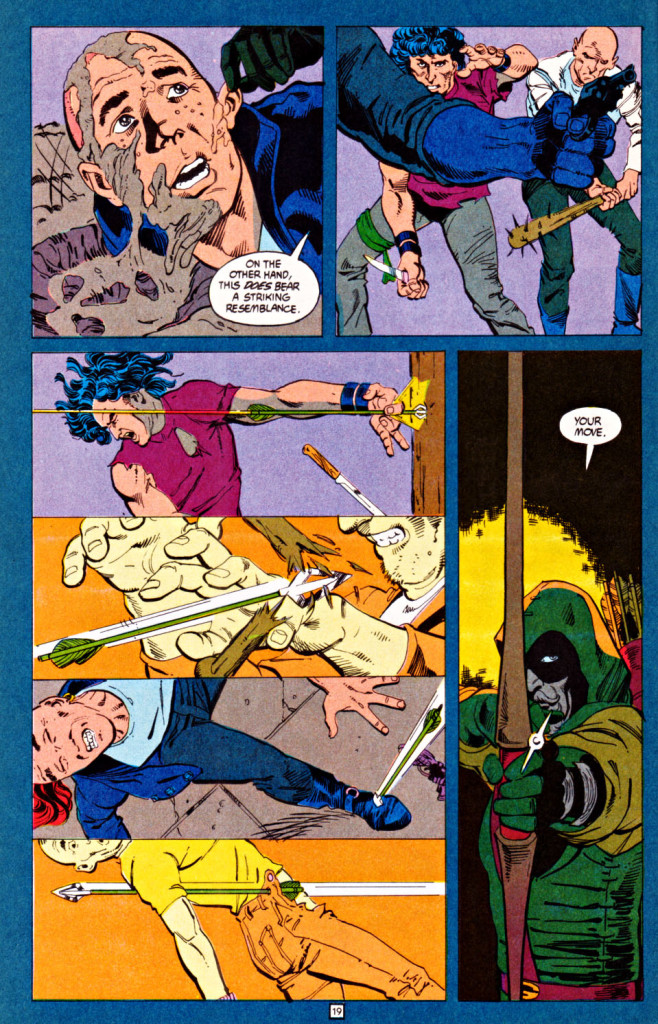 Green Arrow (v2) #13
Green Arrow (v2) #13
(The mix of skins and punks in the gang is a bit confusing, though. Doesn’t their leader know that skinheads aren’t allowed in Mohawk Town?)
Notably, Mike Grell stripped Oliver Queen’s life of any superhero shenanigans – the protagonist wasn’t even referred to as ‘Green Arrow’ despite that being the title of the series! Yet, perversely, part of the fun of reading the comic is spotting how far Grell can get away with acknowledging that these tales take place in the DC Universe while hiding any otherworldly elements. Dinah Lance was still around, but she lost her Black Canary sonic scream powers as a result of the torture she endured in The Longbow Hunters (she didn’t even suit up until issue #59, except for some foreplay in #34). Hal Jordan (aka Green Lantern) showed up in issues #19 and #20 (and in a photo in #69) but he didn’t wear his signature costume or magic ring. He also didn’t *explicitly* mention the fact that they had once fought a telepathic girl who looked like Richard Nixon:
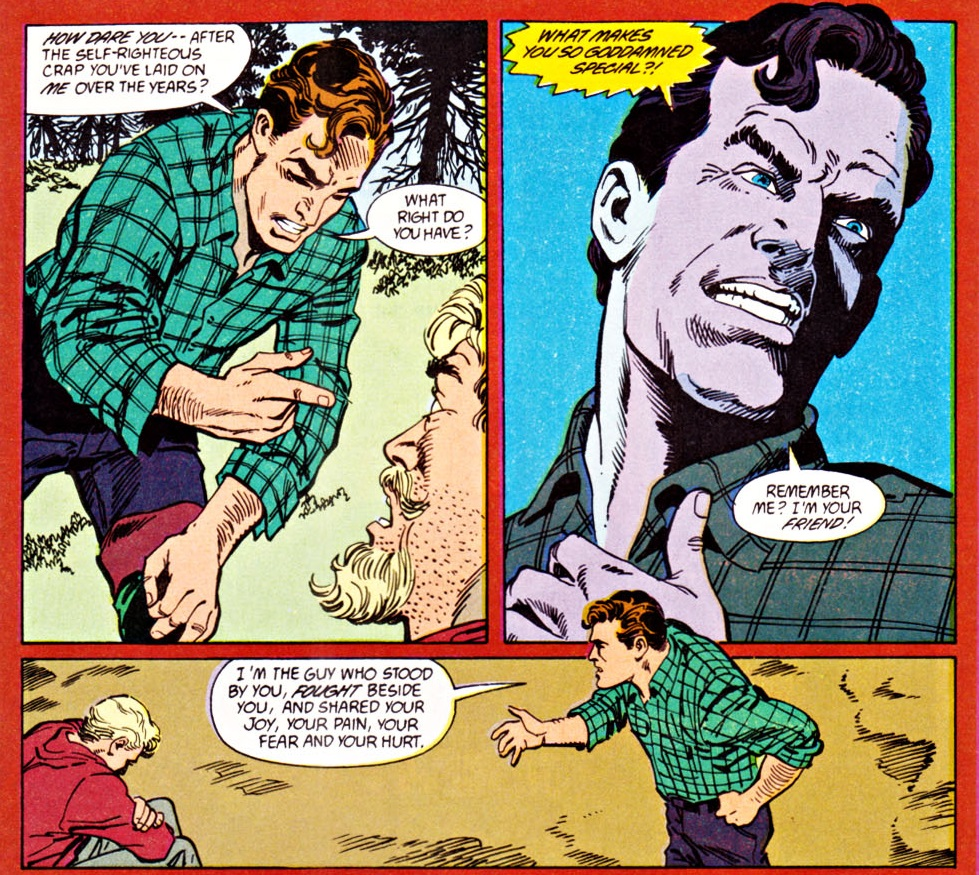 Green Arrow (v2) #20
Green Arrow (v2) #20
John Constantine (of Hellblazer fame) had a cameo in issue #25. Travis Morgan (of The Warlord fame) popped up in issues #27 and #28. Grell, who had created Travis back in 1975, played with how similar the two heroes looked, with several characters unable to tell them apart. And beautifully, Mike Grell managed to fit this warrior from a sword & sorcery comic into Green Arrow’s more grounded tone by only alluding to the character’s origin in very cryptic terms:
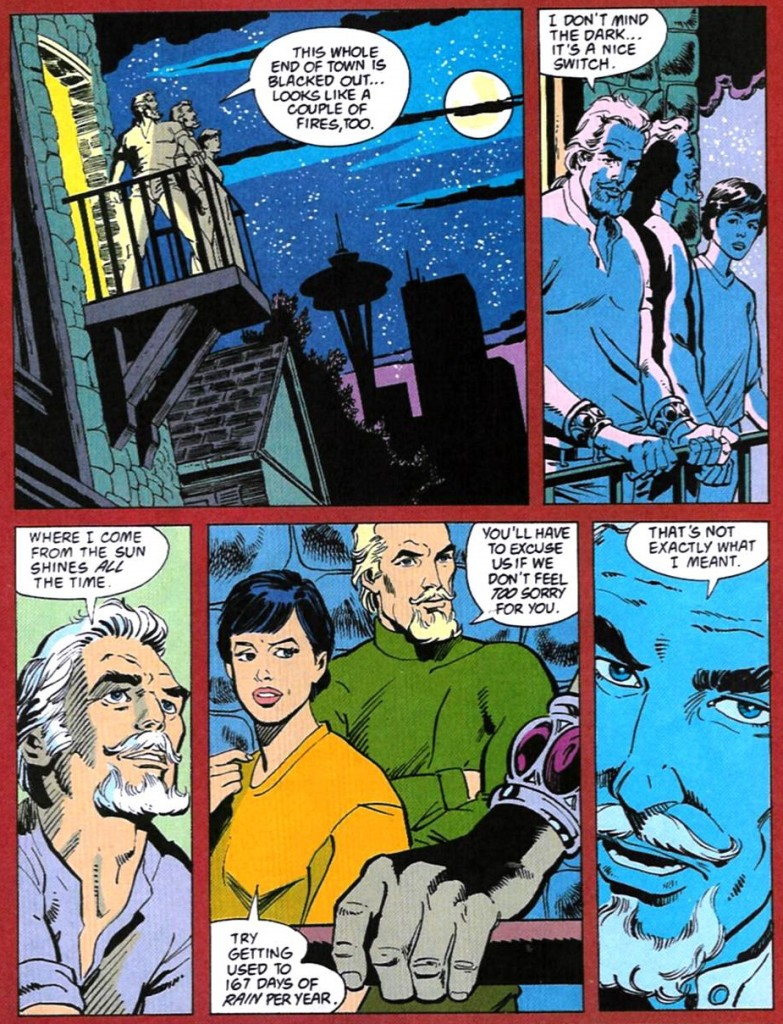 Green Arrow (v2) #28
Green Arrow (v2) #28
Apart from Green Arrow and Black Canary, the only other hero to show up in costume was Roy Harper, who had upgraded from Speedy to Arsenal. This was close to the end of Grell’s run, in issue #75!
For all the winks to the DC Universe, Mike Grell decisively kept his feet in our own reality, dealing with topical issues such as gay-bashing, oil spills, and illegal poaching (although sadly we never got to see Ollie’s reaction to the premiere of Mel Brooks’ Robin Hood: Men in Tights). While the comic didn’t usually feel as preachy as back in Denny O’Neil’s time, Grell often engaged with real world politics, like in issues #61-62, where Green Arrow and Black Canary came across a town violently torn over the possible institution of a military draft. Significantly, Oliver Queen seemed to shift from a mouthpiece of liberal progressivism into more telluric libertarian territory, especially as the vigilante sometimes used deadly force and lawlessly fought against sinister government conspiracies. At one point, Ollie even befriended an IRA terrorist.
In line with this political undercurrent, one of the most awesome additions to Green Arrow’s cast was the cynical mercenary Eddie Fyers, who was amusingly unpredictable.

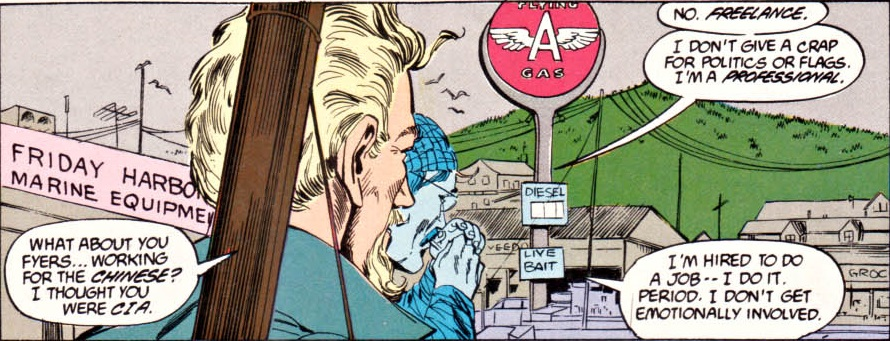 Green Arrow (v2) #4
Green Arrow (v2) #4
This is a scene from the ‘The Champions,’ in which the Soviets send Green Arrow to retrieve a strayed biological weapon before the Chinese can get their hands on it. (Hey, it was the late Cold War, OK? They were getting desperate!)
Oliver Queen’s involvement with shadowy agencies doesn’t stop there. In ‘Here There Be Dragons,’ the CIA blackmails our hero into recovering a treasure map (although of course things prove to be way more complicated than that). In ‘Blood of the Dragon,’ he prevents the assassination of a major world leader. In ‘The Black Arrow Saga,’ Ollie is arrested for treason, having been framed for helping to blow up a U.S. Navy vessel in the Panama Canal (leading to a great moment in which he tells President George Bush to kiss his ass). He works with the Mossad in ‘…And Not a Drop to Drink.’
In ‘Seattle & Die,’ Green Arrow meets a mercenary who fought in Rhodesia and Mozambique and who is now on the run from the Australian Security Intelligence Organization. Check out this nice moment they share:
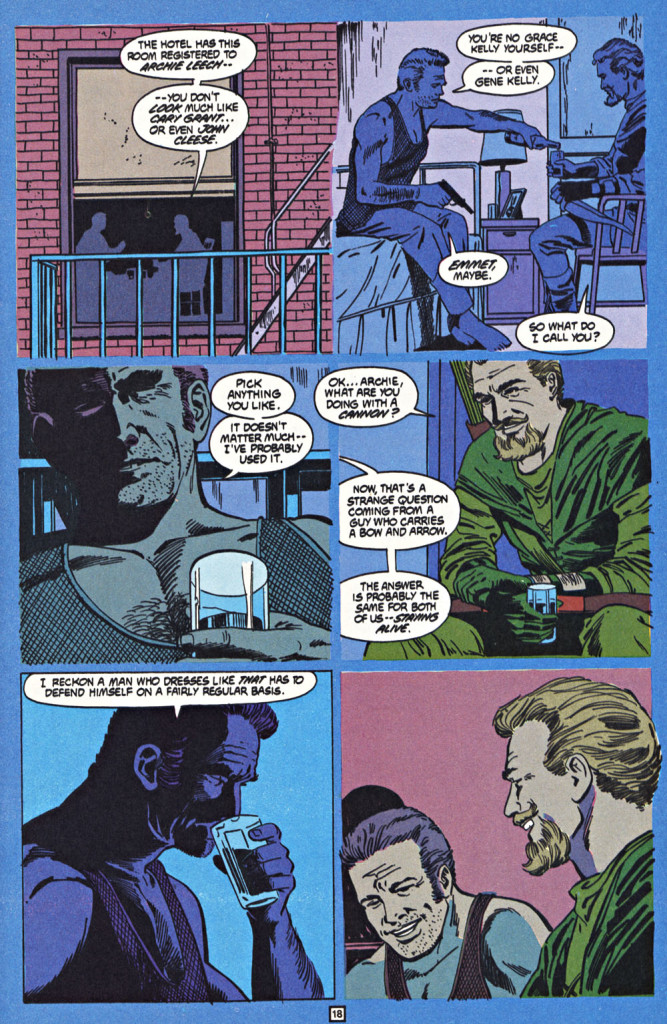 Green Arrow (v2) #15
Green Arrow (v2) #15
As you can probably tell by now, many of these comics involved male bonding between Oliver Queen and other tough guys. But it wasn’t a total sausage fest. Dinah Lance had a strong presence and a well-rounded arc throughout the series. For one thing, after dealing with the trauma of the earlier torture scene, Dinah got to rescue Ollie when he found himself in a similar predicament and break with the gender stereotype. And crucially, The Longbow Hunters had introduced Shado, a mysterious Japanese archer whose family had suffered in a WWII internment camp. She became part of a cool yearly tradition – Mike Grell wrapped Shado-related storylines around Ollie’s birthdays, with the two characters growing increasingly closer. Grell also gave Shado her own spinoff mini-series, the hard-hitting Song of the Dragon.
In another Grell-written spinoff, The Wonder Year, the writer expanded Green Arrow’s origin (he had already briefly reimagined it in The Longbow Hunters and, with greater detail, in the neat Secret Origins #38). This series was particularly fun because it was set in the 1970s, so Grell got to play with that era’s own brand of conspiratorial paranoia (the kind you see in movies like The Parallax View or The Conversation). What’s more, we got to see Ollie trying out his old costume:
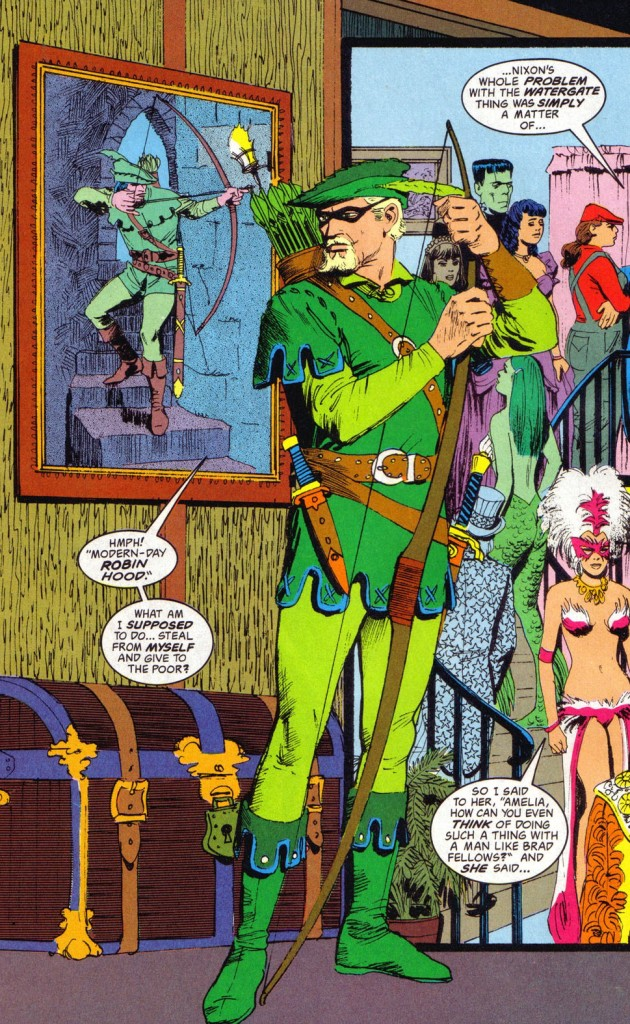 The Wonder Year #2
The Wonder Year #2
Unsurprisingly, after Mike Grell left Green Arrow the tone of the book quickly turned quite superhero-y, which at the time actually felt like a refreshing change. Since then, attempts to explore the character have scored almost as many hits as misses. Chuck Dixon’s enjoyable run on the title followed up on Grell’s contributions even though it mostly focused on Ollie’s son, Connor Hawke. Kevin Smith’s flawed yet entertaining run returned the focus to Oliver Queen, but this version had no recollection of the events of The Longbow Hunters or anything since then – in fact, neither Smith nor his successor Brad Meltzer shared Grell’s spirit of down-to-earth antics, instead they proudly embraced the full mythology of the DC Universe.
More recently, the writer-artist-colorist team of Jeff Lemire, Andrea Sorrentino, and Marcelo Maiolo did a hyperkinetic take on the rebooted Oliver Queen that clearly drew some inspiration from the Grell era, although it was much more inward-looking, with little interest in contemporary affairs. Also, I’m pretty sure the creators of the Arrow TV show aren’t completely unfamiliar with those comics…
At the end of the day, Mike Grell’s work on Green Arrow remains essential reading for fans of hardcore vigilante action and gritty crime fiction, particularly those who also get a kick out of Batman’s more street-level exploits!
NEXT: The Punisher.

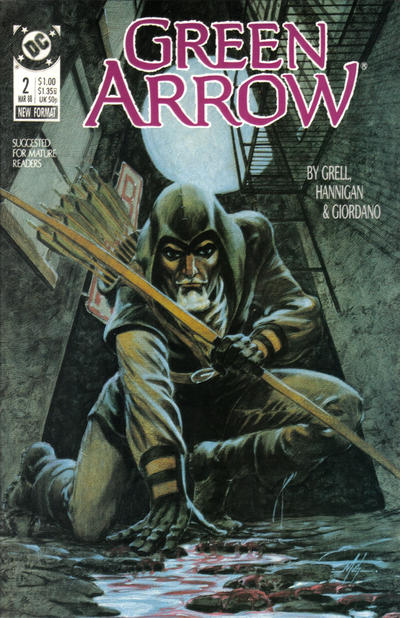
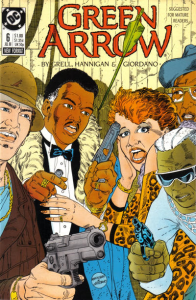
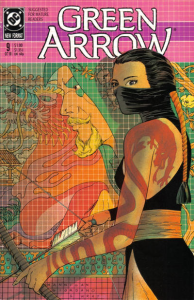
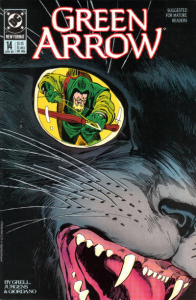
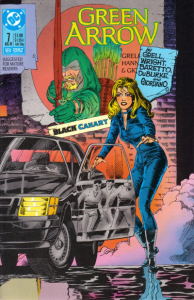
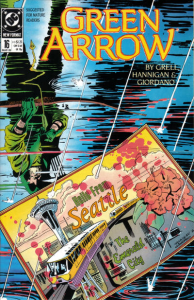
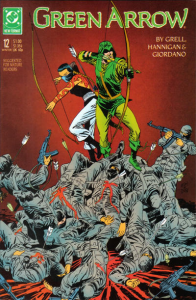
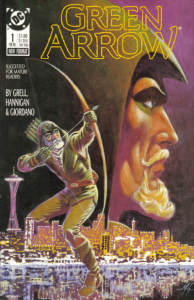
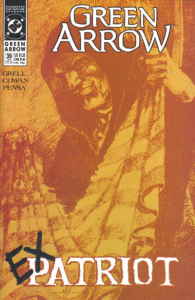
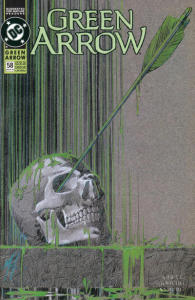
Great article! I enjoy Grell’s GA a lot, though I’m usually more into modern stuff from Image Comics etc. Now that I found an entry into more classic comics with Green Arrow: Can you recommend some Batman Collections that are similar in style? I only know the more popular and/or modern classics like Year One, Dark Knight Returns, Long Halloween…
Kind Regards
Alex
Sure! As far as Batman collections go, the closest thing to GA’s mature, gritty style are Gordon of Gotham, Shaman, After the Fire, Prey, and the first New Gotham volume. Although more difficult to track down, Conspiracy, Night Cries, and The Hill also definitely share a vibe with Grell’s run. Above all, though, you’ll want to check out the Gotham Central books, which are some of the best crime comics out there!
I already read the Gotham Central Omnibus, but never heard of all the other stories you mentioned. I will dive into it!
Much appreciated!